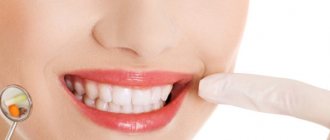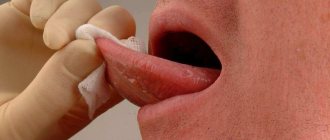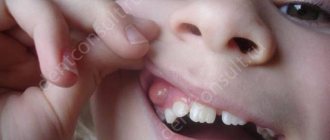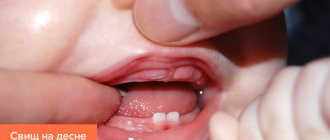Food debris, accumulations of bacteria and saliva form a film that tightly adheres to the enamel, tongue, gum edge and even orthodontic structures. This film is plaque and is called dental plaque. It is impossible to prevent its formation. Within a few minutes after cleaning, plaque begins to form again. In the absence of daily hygiene, the film gradually hardens with the formation of tartar. But even proper regular brushing of teeth does not always prevent the appearance of deposits.
Dentists at the Nurimed clinic will conduct a professional examination of the oral cavity, determine the causes of plaque formation and help get rid of it using innovative technologies and modern equipment. You can make an appointment by phone or by using the feedback form.
What is plaque on teeth and how is it formed?
Plaque on tooth enamel is deposits formed by microscopic food debris, bacteria and their waste products.
The deposits have a soft consistency because they have not had time to mineralize. Obviously, each of us follows oral hygiene in one way or another. Some people do it better, some do it worse. But even the most meticulous neat person will not be able to clean plaque from hard-to-reach places in the mouth. These include: interdental spaces, fissures, the border between the tooth and the gum, areas around fillings, braces. Stages of tooth decay caused by plaque:
- the formation of a thin film (pellicles) of salivary glypoproteins on the surface of the teeth a few minutes after eating. The negatively charged sticky surface of the enamel begins to attract positively charged microorganisms;
- growth of microflora on film;
- the formation of a plaque with the activation of the vital activity of hundreds of billions of bacteria, which convert sugar into acid, which gradually demineralizes the enamel layer;
- the plaque blocks access to the enamel of oxygen, calcium and phosphorus;
- transformation of soft plaque into tartar, tooth destruction.
Tartar: removal
When you brush your teeth, you can only remove soft plaque from the surface of your teeth. Partially mineralized plaque, as well as hard dental deposits, can no longer be removed by regular teeth cleaning at home. And in this case, only a dentist can clean the tartar.
1) Cleaning the stone at the dentist’s appointment –
The traditional way to remove hard plaque is ultrasonic teeth cleaning. In this case, stone removal is carried out using an ultrasonic scaler. Removing supragingival calculus is a very simple procedure, and 1 hour is enough to remove calculus from all teeth. But to effectively remove subgingival stones, you need several visits and a highly qualified doctor. Therefore, it is best to remove stones not from ordinary dental therapists, but from periodontists (these are dentists who specialize in the treatment of gum inflammation).
Ultrasonic tartar removal –
There is also the “AirFlow” procedure, with which you can remove small dental deposits, pigment plaque, and polish your teeth. In this case, cleaning and polishing of teeth occurs due to a water-air mixture containing granules of an abrasive substance, sprayed under high pressure from a special tip. But AirFlow will not be effective against massive hard dental plaque, which in any case will first have to be removed with ultrasound.
Tartars: photos before and after their removal
On average, the price for tartar removal is about 100-150 rubles per 1 tooth, including polishing.
2) How to remove tartar at home –
Some patients use recipes for removing plaque, which are replete with many unprofessional websites, promising complete relief from tartar. We'll disappoint you, but these methods not only don't work, but also cause harm to tooth enamel and gums. Just for fun, you can check them out at the link above.
It is impossible to remove well-mineralized tartar and dense pigment plaque with any home remedies. However, not too pronounced pigment plaque and only partially mineralized plaque can still be removed with the help of the following modern dental care products. First of all, we are talking about Oral-B electric toothbrushes - in combination with special highly abrasive toothpastes.
Important: Oral-b electric brushes have a round head with bristles that performs 8,800 reciprocating movements per minute, as well as a minimum of 20,000 pulsating movements. Pulsations help loosen dense plaque (even that which may already be partially mineralized), and rotational movements sweep it away and polish the teeth. This brush is a miniature dentist’s tool and is probably familiar to everyone who has gone to the dentist for professional oral hygiene.
The second component is highly abrasive toothpastes, which can help remove pigmented and partially mineralized plaque. They can only be used once a week. If you are using them in combination with an Oral-b electric brush, it is advisable to use the electric brush only at low speed (in the “whitening/polishing” mode). You can find out how this is done correctly and what toothpastes are used at the link below.
You can also purchase professional teeth polishing products, which the dentist uses to finish polishing teeth after ultrasonic cleaning (they are sold in stores that sell consumables for dental clinics). For example, pastes such as “Detartrine” or “Detartrine – Z” (this one is more effective). They are able to remove even small tartar and not too pronounced smoker’s plaque. Used in combination with an Oral-B electric toothbrush (rotation of the nozzle should be at low speed).
→ Scheme for removing dental plaque at home
Types of plaque
Soft deposits consist of pathogenic microflora: streptococci, staphylococci, lactobacilli, leptotrichia, etc., as well as their metabolic products. Among microorganisms there are those that contain a coloring pigment. Therefore, dental plaque can be colored in any color:
- white or slightly yellowish is formed due to poor hygiene;
- gray indicates a violation of mineralization processes;
- green indicates that the dust is dominated by bacteria whose waste products contain chlorophyll;
- yellow informs that the deposits have been pigmented by food dyes (tea, coffee, etc.);
- brown is formed in smokers or people who secrete iron that is not absorbed by the body in their saliva;
- black or dark brown is formed, as a rule, on milk teeth with a predominance of pigment-forming bacteria.
Yellow teeth in a child: what are the reasons?
Children are susceptible to increased plaque formation, usually green or yellow in color. This is especially common in adolescents, when hormonal changes occur in the body during puberty. There is no great danger in this, the main thing is to monitor hygiene, and also take your child to the dentist for professional cleaning on time.
You can find a trusted dentist in your city using a simple search system on our website. Just enter the parameters you need.
Signs and causes of plaque formation
It is difficult not to notice the appearance of soft and hard deposits on the teeth. Moreover, the process is accompanied by the following phenomena:
- change in enamel color and loss of shine;
- surface roughness;
- the appearance of bad breath.
During a consultation, the dentist can assess the negative impact of deposits on the general condition of the oral cavity based on the following factors: the depth of periodontal pockets, the intensity of gum bleeding, and tooth mobility.
Causes of dental plaque:
- insufficient oral hygiene, including when correcting bites with braces;
- lack of solid foods in the diet and the predominance of easily digestible carbohydrates;
- smoking;
- gastrointestinal diseases and metabolic disorders;
- hereditary factor;
- taking certain medications and iron supplements;
- climate change;
- age-related demineralization of enamel.
Main reasons
When plaque occurs on the teeth of children over two years of age, there may be several reasons for this phenomenon, but the main ones are:
- Fungal infections developing in the oral cavity;
- Dysbacteriosis;
- Lack of proper oral hygiene;
- Excessive amount of sweets consumed with a shortage of fruits and vegetables;
- Bottle feeding babies at night;
- Chewing food on one side (plaque forms on the other side).
Cleansing methods
The soft layer of contamination on dental elements is an excellent breeding ground for pathogenic microflora. It multiplies exponentially, becoming a source of infection and, as a result, the cause of caries, gum problems and gastrointestinal diseases. Dentists have learned to effectively deal with the problem. Once upon a time, cleansing was carried out manually, it was not effective enough and was accompanied by pain. Now, special devices are used for cleaning, which allow 100% destruction of pathogenic flora. Experts recommend doing this procedure at least once a year.
The most popular method is cleansing using an Air Flow device. Mechanism of action: a solution containing tiny abrasive particles is applied to the surface of the enamel layer under pressure. They gently “bombard” plaque, destroying it and washing it away. Hard tartar is removed with an ultrasonic scaler. Once cleaning is complete, the enamel is polished and a fluoride varnish is applied to remineralize it.
Important: self-medication is dangerous. Do not try to remove dirt with sharp objects (needle, knife, etc.). This is fraught with injury to the gums, chips, and the risk of swallowing the cleaning tool.
Dentists' advice on oral hygiene at home
Doctors remind that the process of plaque formation does not stop for a minute, so home care and some nutritional rules are mandatory.
Experts recommend quitting smoking and reducing consumption of foods and drinks containing large amounts of food coloring. It is also necessary to increase the amount of solid food in the diet and promptly treat diseases of the gastrointestinal tract. Recommendations for hygienic care:
- Teeth should be brushed at least twice a day;
- After eating or drinking, you should rinse your mouth;
- For effective cleansing, you need to use not only a toothbrush and toothpaste, but also floss and an irrigator.
Note: doctors say a firm “No” to the use of hydrogen peroxide and soda. This can cause burns to the mucous membrane and accelerated abrasion of the enamel.
The dental network offers services for diagnosing and removing plaque on teeth. Our specialists are highly qualified and regularly improve their skills in leading clinics in Russia and Europe. We have a system of family and cumulative discounts.
You can contact any of the branches of our center in Moscow, located within walking distance from metro stations:
- Art. Alekseevskaya (VDNKh district, etc. Mira), address: st. 3rd Mytishchiskaya house 3, building 2;
- Art. Shelepikha, address: Shelepikhinskaya embankment, address: building 34, building 1.
Entrust the health of your teeth to professionals; we will be able to reliably protect you from dental and periodontal diseases. Remember that prevention is the best defense! We are waiting for you every day, seven days a week.
Prevention
The formation of deposits on enamel is a physiological process that cannot be eliminated completely. However, there are general rules to reduce the intensity of its formation and minimize pathological consequences. These include:
- Personal hygiene. You should brush your teeth at least twice every day. In this case, you need to follow the cleaning rules recommended by dentists in order to get rid of the maximum amount of food debris and bacteria.
- Correct selection of paste and brush. Choosing the right teeth cleaning tools matters more than many people think. The brush should not injure the gums. It needs to be changed every 3 months. The paste is selected according to age.
- Using dental floss and mouthwash. Dental floss allows you to get rid of food debris and deposits in the spaces between the teeth. The rinse has a beneficial effect on the condition of the enamel and promotes the normal functioning of the gums. It can be used after meals to reduce the amount of bacteria in the mouth.
- Timely treatment. Diseases of the oral cavity, gastrointestinal tract, and other systems must be treated promptly and correctly. Self-medication can only aggravate the situation and lead to complications.
- Proper care. Orthodontic structures in the oral cavity require separate cleaning and care. Ignoring this factor not only leads to increased formation of deposits, but can also cause the development of an inflammatory process.
- To give up smoking. A bad habit negatively affects the entire body.
- Avoiding excessive consumption of coffee, tea, and coloring drinks.
Every person should have their teeth professionally cleaned once a year to remove tartar and hard deposits on the enamel. This allows you not only to improve the appearance of your teeth, but also to prevent a number of oral diseases. The reason why you should contact Nurimed is an individual approach to each client’s problem followed by a comprehensive solution.










